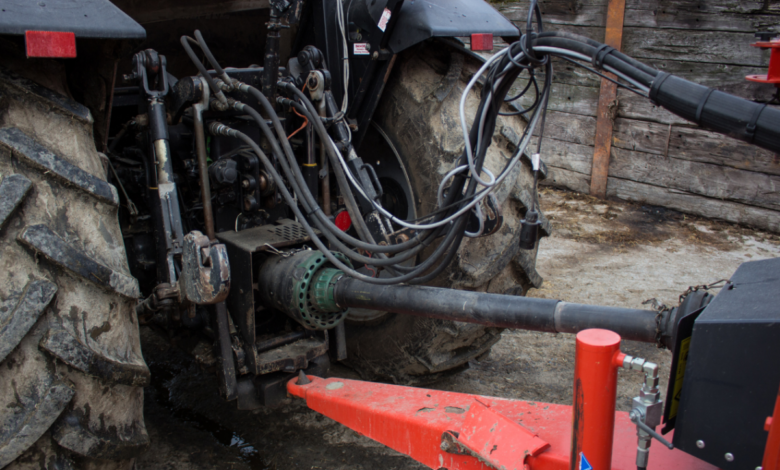The Ultimate Guide to Power Take-Off: Everything You Need to Know

Key Takeaways:
- Power take-off (PTO) is a mechanism that transfers power from an engine to another machine or implement.
- PTO systems benefit industrial machines by enabling the use of a single engine for multiple functions, enhancing versatility, and reducing costs.
- PTO systems increase efficiency and productivity by utilizing a single engine, allowing for seamless integration of attachments, providing consistent power supply, and customization of power transmission.
- When choosing a PTO system, consider power requirements, mounting location, engine compatibility, transmission system compatibility, and safety features.
- Common mistakes to avoid when choosing a PTO system include neglecting power requirements, space limitations, input speed and torque compatibility, transmission system compatibility, and safety features.
- Proper installation and maintenance of PTO systems are essential for optimal performance and reliability.
- Installation steps include identifying mounting location, selecting the right PTO system, removing interfering components, following manufacturer’s guidelines, and testing functionality.
- Maintenance practices include following recommended schedules, cleaning, inspecting, lubricating, replacing worn parts, and ensuring proper alignment and tension.
- Common issues with PTO systems include improper engagement or disengagement, unusual noises or vibrations, and fluid leaks.
- To maximize performance, optimize power transmission efficiency, enhance safety features, and stay informed about emerging technologies and trends.
- Emerging technologies and trends in PTO include electric systems, integration with telematics and IoT, sustainability, and advancements in control systems.
Why Power Take-Off Is a Game Changer for Machines
Power take-off (PTO) is a crucial component in various industries, enabling machines to efficiently transfer power from the engine to other mechanical devices. Whether it’s a truck, tractor, or industrial equipment, PTO systems play a vital role in enhancing productivity and versatility. In this section, we will delve into the basics of power take-off, its benefits for industrial machines, and how it improves efficiency and productivity.
The Basics: What Is Power Take-Off?
Power take-off, commonly referred to as PTO, is a mechanism that enables the transfer of power from an engine to another machine or implement. It derives power from the main engine or motor and transmits it to a secondary device through a driveshaft or other mechanical components.
PTO systems typically consist of a gearbox, clutch, and driveshaft. The gearbox provides the necessary power conversion, allowing the engine’s rotational energy to be transferred at a different speed or torque to the driven equipment. The clutch, on the other hand, facilitates engagement and disengagement of the PTO system to control power transmission.
The Benefits of Power Take-Off for Industrial Machines
Industrial machines, such as construction equipment, agricultural machinery, and utility vehicles, greatly benefit from the inclusion of power take-off systems. These systems offer several advantages, making them a game changer for machines in various industries.
One of the key benefits of power take-off is the ability to utilize a single engine to power multiple machines or functions. This eliminates the need for separate engines, reducing costs and increasing operational efficiency. Additionally, PTO systems enable machines to have a compact design by eliminating the need for separate power sources for each function.
Moreover, power take-off systems allow for seamless integration of attachments and implements, enhancing the versatility of machines. For example, in agriculture, PTO systems enable tractors to power various farm implements, such as mowers, sprayers, and hay balers. This versatility increases productivity and decreases downtime, as machines can quickly adapt to different tasks.
How Power Take-Off Increases Efficiency and Productivity
Power take-off systems play a crucial role in improving efficiency and productivity in various industries. By utilizing the power generated by a single engine, machines can perform multiple functions without the need for additional power sources. This reduces fuel consumption and minimizes equipment costs.
In agricultural applications, PTO systems enable farmers to efficiently operate a wide range of implements, such as seeders, tillers, and harvesters. This increases the overall productivity of the farming operation and allows for timely completion of tasks.
Additionally, power take-off systems contribute to the smooth operation of machinery by providing a consistent power supply. This ensures that machines can operate at optimal performance levels, resulting in improved efficiency and reduced downtime.
Furthermore, PTO systems allow for the customization of power transmission to suit specific applications. By adjusting the speed and torque of the PTO, machines can optimize their performance based on the requirements of the task at hand. This flexibility enhances productivity and ensures efficient power delivery.
Choosing the Right Power Take-Off System for Your Application
When it comes to selecting a power take-off system for your specific application, there are several factors to consider. Understanding the different types of PTO systems available, as well as the key considerations and common mistakes to avoid, will help ensure that you choose the right system for your needs.
Understanding the Different Types of Power Take-Off Systems
Power take-off systems come in various types, each designed to suit specific applications and requirements. It is important to understand the different types of PTO systems to determine which one is best suited for your application.
Some of the common types of PTO systems include side-mounted PTOs, rear-mounted PTOs, and split-shaft PTOs. Side-mounted PTOs are often used in commercial trucks and provide power to devices such as hydraulic pumps. Rear-mounted PTOs are commonly found in tractors and agricultural machinery, powering implements like mowers, balers, and augers. Split-shaft PTOs are suitable for heavy-duty applications, such as large trucks and industrial equipment.
Factors to Consider When Selecting a Power Take-Off System
Choosing the right power take-off system involves considering several factors to ensure optimal performance and compatibility with your application. Some key factors to consider include:
- The power requirements of the driven equipment
- The mounting location and available space for the PTO system
- The input speed and torque of the main engine
- The compatibility of the PTO with the transmission system
- The safety features and certifications of the PTO system
By carefully evaluating these factors, you can select a PTO system that meets the specific needs of your application and ensures reliable power transmission.
Common Mistakes to Avoid When Choosing a Power Take-Off System
When choosing a power take-off system, it is important to avoid common mistakes that can lead to compatibility issues or performance limitations. Some common mistakes to avoid include:
- Not considering the power requirements of the driven equipment
- Overlooking the space limitations for PTO installation
- Ignoring the input speed and torque compatibility with the main engine
- Failing to verify the compatibility of the PTO with the transmission system
- Not considering the safety features and certifications of the PTO system
Avoiding these mistakes will help ensure that you choose the right power take-off system for your specific application and avoid costly compatibility issues or performance limitations.
Installation and Maintenance Tips for Power Take-Off Systems
Proper installation and regular maintenance of power take-off systems are essential to ensure optimal performance, reliability, and longevity. In this section, we will explore key steps for installing a power take-off system, best practices for maintenance and servicing, and troubleshooting common issues that may arise.
Key Steps for Properly Installing a Power Take-Off System
The installation of a power take-off system requires careful planning and adherence to specific steps to ensure proper functionality and compatibility with the main engine and driven equipment. Here are some key steps to follow when installing a power take-off system:
- Identify the mounting location and ensure sufficient space for installation.
- Select the appropriate PTO system based on power requirements and compatibility.
- Remove any existing components that may interfere with PTO installation.
- Install the PTO system according to the manufacturer’s guidelines.
- Connect the driveshaft or other power transmission components to the driven equipment.
- Verify proper engagement and disengagement of the PTO system.
- Test the PTO system to ensure proper functionality before putting it into operation.
By following these steps and consulting the manufacturer’s instructions, you can ensure a successful installation of your power take-off system.
Best Practices for Maintaining and Servicing Power Take-Off Systems
Regular maintenance and servicing are crucial for the longevity and reliability of power take-off systems. Here are some best practices to follow:
- Follow the manufacturer’s recommended maintenance schedule for your specific PTO system.
- Clean and inspect the PTO system regularly to ensure proper operation and identify any potential issues.
- Lubricate the moving parts of the PTO system as recommended by the manufacturer.
- Check for any leaks or abnormal noises that may indicate a problem with the PTO system.
- Replace worn or damaged components promptly to prevent further damage or failure.
- Ensure proper alignment and tension of the driveshaft or other power transmission components.
By adhering to these best practices, you can maintain the performance and reliability of your power take-off system and minimize the risk of unexpected downtime or costly repairs.
How to Troubleshoot Common Issues with Power Take-Off Systems
Despite regular maintenance, power take-off systems may encounter issues that require troubleshooting. Here are some common issues that may arise and their possible solutions:
Issue: PTO not engaging or disengaging properly. This may indicate a problem with the clutch or linkage. Check for proper adjustment and linkage alignment. If necessary, consult a professional for further inspection and adjustment.
Issue: Unusual noises or vibrations during PTO operation. This could be a sign of worn bearings, misalignment, or damaged components. Inspect the PTO system for any visible damage, and consider replacing worn or damaged parts.
Issue: Leaking fluid from the PTO system. Check for leaks at seals and connections. Replace any damaged seals or tighten loose connections. If the issue persists, consult a professional for further assessment.
It is important to address any issues promptly to prevent further damage or failure of the power take-off system. Consulting the manufacturer’s documentation or seeking professional assistance can help identify and resolve the problem effectively.
Maximizing the Performance of Your Power Take-Off System
To maximize the performance of your power take-off system, there are several tips and strategies you can implement. These include optimizing power transmission efficiency, enhancing safety features, and staying informed about emerging technologies and trends in the industry.
Tips for Optimizing Power Transmission Efficiency
Efficient power transmission is crucial for maximizing the performance of your power take-off system. Here are some tips to optimize power transmission efficiency:
- Ensure proper alignment of the PTO system and driven equipment.
- Use high-quality lubricants and follow manufacturer’s recommendations for lubrication.
- Regularly inspect and maintain the PTO system to prevent wear or misalignment.
- Consider upgrading to more efficient PTO system components or accessories.
- Monitor power transmission performance and identify any areas for improvement.
By implementing these tips, you can improve power transmission efficiency and maximize the overall performance of your power take-off system.
Enhancing Power Take-Off System Safety Features
Safety is of utmost importance when dealing with power take-off systems. Enhancing the safety features of your PTO system can help prevent accidents and ensure the well-being of operators and other personnel. Some safety measures to consider include:
- Installing guards or shields to prevent contact with moving parts of the PTO system.
- Implementing safety interlocks or sensors to prevent unintentional engagement of the PTO.
- Providing proper training for operators on the safe use and operation of the PTO system.
- Regularly inspecting and maintaining safety components, such as guards and interlocks.
- Following relevant safety regulations and guidelines specific to your industry.
By prioritizing safety and implementing these measures, you can minimize the risk of accidents and create a safe working environment when using power take-off systems.
The Future of Power Take-Off: Emerging Technologies and Trends
The field of power take-off is continuously evolving, with emerging technologies and trends shaping its future. Staying informed about these advancements can help you stay ahead of the curve and make informed decisions about your power take-off systems. Some notable emerging technologies and trends in the field of power take-off include:
- Electric PTO systems: The adoption of electric power take-off systems is gaining traction, offering benefits such as reduced emissions, quieter operation, and improved efficiency.
- Integration with telematics and IoT: The integration of power take-off systems with telematics and IoT technologies enables real-time monitoring, data analytics, and predictive maintenance.
- Increased focus on sustainability: There is a growing emphasis on developing sustainable power take-off solutions that minimize environmental impact and improve energy efficiency.
- Advancements in control systems: The development of advanced control systems and automation technologies allows for more precise and efficient management of power take-off systems.
By keeping an eye on these emerging technologies and trends, you can position yourself to take advantage of the latest advancements in power take-off systems and enhance the performance and sustainability of your machinery.
In conclusion, power take-off systems play a crucial role in various industries, enabling machines to efficiently transfer power and enhance productivity. Understanding the basics of power take-off, selecting the right system for your application, proper installation and maintenance, and maximizing performance are key to unlocking the full potential of power take-off. By following the information and tips provided in this comprehensive guide, you can make informed decisions and ensure the optimal performance and longevity of your power take-off systems.
FAQ
Question: What is a Power Take-Off (PTO)? – Power take-off (PTO) is a mechanism that enables the transfer of power from an engine to another machine or implement. It derives power from the main engine or motor and transmits it to a secondary device through a driveshaft or other mechanical components.
Question: How does a Power Take-Off (PTO) system work? – A power take-off (PTO) system typically consists of a gearbox, clutch, and driveshaft. The gearbox provides the necessary power conversion, allowing the engine’s rotational energy to be transferred at a different speed or torque to the driven equipment. The clutch facilitates engagement and disengagement of the PTO system to control power transmission.
Question: What are the benefits of Power Take-Off (PTO) for industrial machines? – Power take-off systems offer several benefits for industrial machines. They allow for the use of a single engine to power multiple machines or functions, reducing costs and increasing operational efficiency. PTO systems also enable seamless integration of attachments and implements, enhancing the versatility of machines. They increase efficiency and productivity by providing a consistent power supply and allowing customization of power transmission.
Question: How does Power Take-Off (PTO) increase efficiency and productivity? – Power take-off (PTO) systems increase efficiency and productivity by utilizing a single engine to power multiple functions, eliminating the need for additional power sources. This reduces fuel consumption and minimizes equipment costs. PTO systems also contribute to the smooth operation of machinery by providing a consistent power supply, optimizing performance levels, and ensuring efficient power delivery.
Question: What factors should be considered when choosing a Power Take-Off (PTO) system? – When choosing a power take-off system, consider factors such as power requirements of the driven equipment, mounting location and available space, input speed and torque compatibility with the main engine, compatibility with the transmission system, and safety features and certifications of the PTO system.
Question: What are some common mistakes to avoid when choosing a Power Take-Off (PTO) system? – Some common mistakes to avoid when choosing a power take-off system include neglecting the power requirements of the driven equipment, overlooking space limitations for PTO installation, ignoring input speed and torque compatibility, failing to verify compatibility with the transmission system, and not considering the safety features and certifications of the PTO system.
Question: What are the key steps for properly installing a Power Take-Off (PTO) system? – Key steps for properly installing a power take-off system include identifying the mounting location, selecting the appropriate PTO system, removing interfering components, following the manufacturer’s guidelines for installation, connecting the driveshaft or power transmission components, verifying proper engagement and disengagement, and testing the functionality of the PTO system.
Question: What are some best practices for maintaining and servicing Power Take-Off (PTO) systems? – Some best practices for maintaining and servicing power take-off systems include following the manufacturer’s recommended maintenance schedule, cleaning and inspecting the PTO system regularly, lubricating the moving parts, checking for leaks or abnormal noises, replacing worn or damaged components, and ensuring proper alignment and tension of power transmission components.



